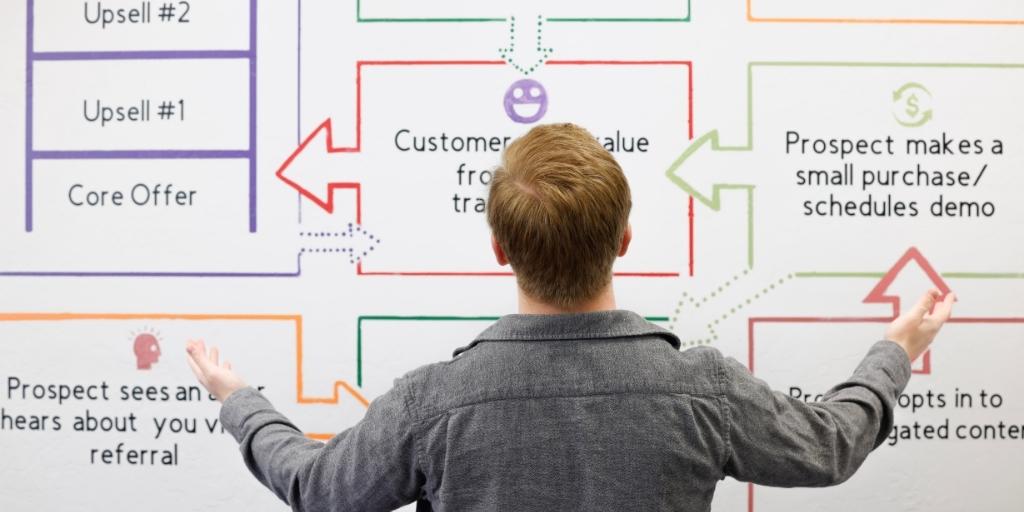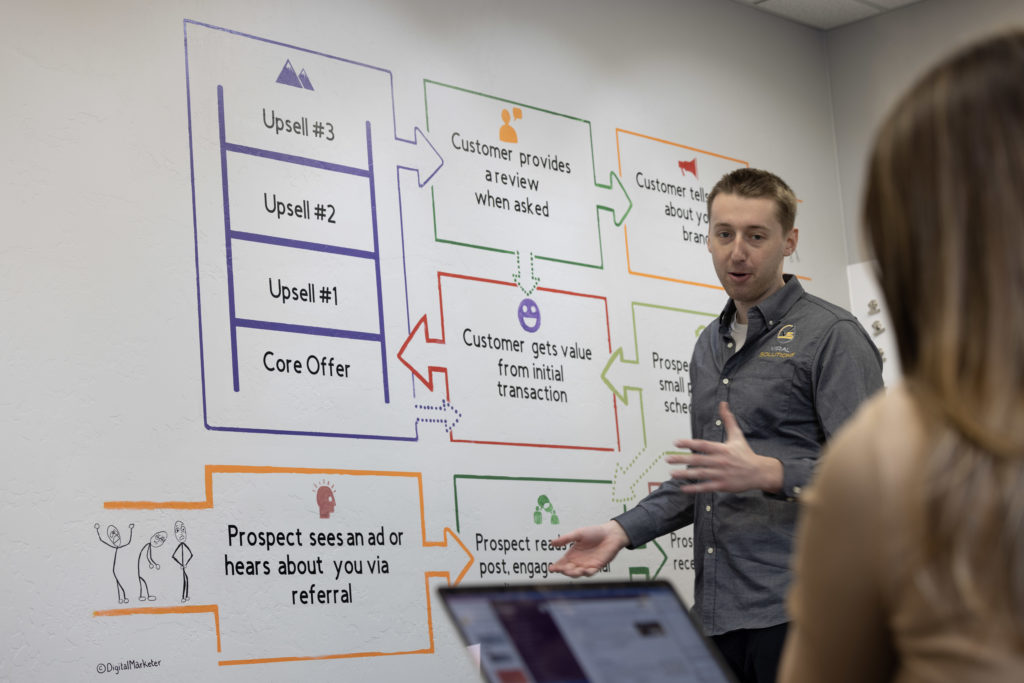
What Is the Customer Value Journey™?
Two things are certain when it comes to successful marketing:
- You must understand your customer.
- You can't just wing it.
You know this already, but do you have a Customer Value Journey™ map?
Put simply, the Customer Value Journey is the step-by-step process that attracts and converts prospects into customers and keeps them coming back. It's an invaluable digital marketing tool that helps marketers improve their conversions and, therefore, their sales and ROI.
(It's also a term coined and trademarked by the smart folks over at DigitalMarketer.)
Don't psshh this because it's powerful stuff.
When you map out this journey, you'll be able to turn cold leads into not just happy customers but raving fans.
Why You Need a Customer Value Journey
When prospective customers become aware of your product and are interested in what it can do for them, they are just at the beginning of the customer journey. Suppose you don't guide and encourage them to take each additional step toward becoming satisfied customers. In that case, they will likely become lost, lose interest, or be distracted by another product or service.
The path is not always linear, but the sequence of steps is critical to leading a prospective customer to conversion.
For your marketing to work effectively, you must guide your prospect at every step along the road. That means providing the right message at each point where they make critical decisions about whether to continue their journey or abandon it.
The Customer Value Journey is the 8-step process you can incorporate into your marketing strategy to guide every prospect to becoming that satisfied customer whose enthusiasm sells your product for you. To succeed, you'll need to create a map of that journey.
How Journey Mapping Helps You Achieve Marketing Success
With the help of a Customer Value Journey map, you can visualize how a customer moves through each stage of that journey to help you create an effective marketing strategy.
Once you have identified your ideal customer—so you know your target audience and have worked out how people who fit the bill become loyal customers—you will be able to map out the journey they'll take.
A chart that shows how prospects move from one step to the next will make it much easier to:
- See the path each customer takes
- Select the right tactics and content that will make the journey easier
- Decide what data you need to collect and analyze
- Decide what points along the journey you need to apply that data
- Identify where you need to make improvements so that leads aren't lost
- Successfully orchestrate your customer journey
- Continually improve your marketing efforts
Companies that map their customer journey are the ones that are succeeding. In fact, according to Hanover Research's report The Power of Customer Journey Mapping 2022, of the 400 businesses surveyed, 76% said that customer journey mapping increases their ROI, and 87% said it is time and money well spent.
What Are the Steps in the Customer Value Journey?

As mentioned previously, the Customer Value Journey isn't always linear. However, there are some basic steps that many people will take in doing business with you (and eventually becoming raving fans). We've outlined these steps below.
Step 1: Aware
With so many different advertisements vying for our attention, you must find a way to stand out and gain the interest of your ideal customers.
Do this through the words you use and the visual images accompanying them. Catch attention and make it impossible for them to pass you by.
This is where you put out top-of-funnel content, including Facebook ads, blog posts, social media posts, word of mouth, and things like webinars and events.
Step 2: Engage
Grabbing their attention makes your audience stop and notice you, but that's all for nothing if you can't get them to engage with you. Conversions can't occur if your audience does not interact with your ads and content.
At this stage of the Customer Value Journey, you need to get your target audience to read your article, watch your video, pop a question on your chatbot, or interact with one of your social media posts.
Engagement might start here, but it certainly doesn't end here. At each step of the Customer Value Journey, you should seek engagement with your audience. Make no mistake about it. Unless they are engaging, they have no emotional interest in your company.
Step 3: Subscribe
Once you've gotten your audience to engage with you, you need to get their contact information so that you can connect with them through email marketing. It is easiest to get email addresses by offering prospects a lead magnet.
They'll fill out a form and give you their email. In exchange, you'll give your lead something for free. That sounds simple, but these days, this step isn't as easy as it used to be.
Let's face it—people are inundated with free content, so it has to be something that stands out and provides a lot of value. While that could be an e-book, guide, or tip sheet, you'll probably do better with something more enticing. Try one of the following:
- Free webinar
- Demo
- Sneak peek
- Free trial
- Free product or service
If you've done steps one and two well, your prospects will already be starting to trust and want more from you. You'll get plenty of subscribers as long as you offer them something they truly want.
Step 4: Convert
If you provided the right freebie to get them to join your list and targeted them correctly, your leads will want to become your customers. You just need to make it easy for them to do so.
Often, the best way to bring about the conversion stage is with an offer that provides high value but with low risk. In many cases, this offer has nothing to do with making a profit. It's just meant to turn your potential customers into customers. If you can cover your costs here, you're golden.
Step 5: Excite
People love to shop, and why? Because it makes them feel good. Those good feelings come from dopamine released when they make a new purchase. And you can capitalize on that excitement.
The more you can get your new customers excited about their purchases, the more you will win them over. At this stage of the Customer Value Journey, you'll want to slap some icing on the cake. Surprise them with extra bonuses, freebies they weren't expecting, or quick wins.
Step 6: Ascend
When someone buys from you once, they are much more likely to buy from you again, especially when they are in the middle of the excitement of buying. As your customer makes a purchase, offer them something that will give them even better results. You can do this by offering a more in-depth product, a consultation to make it work even better, or a done-for-you product.
You can also try as you nurture them further along in your marketing strategy. They might purchase a more comprehensive offering, join a membership, or purchase similar products as you engage with them over time.
This stage is when you start really making a profit. When your customers buy from you more than once, BAM! You've just increased the customer lifetime value and made acquiring new customers more affordable.
Step 7: Advocate
Right after your new customer has purchased from you, that is when they will be most excited about it. And that is when they are most likely to share their experience with others.
Most people are happy to spread the word at this stage in the Customer Value Journey, but they usually need to be asked. Include a share button on their order confirmation page. Send out an automated email asking for a review after they've received your product or service.
If you get this type of endorsement, you'll increase your social proof, which can have dramatic sales advantages.
And while consumers are becoming warier about whether to trust online reviews, they are reading them more than ever. In fact, according to a study by Bright Local, 77% read online reviews when checking out local businesses, and 81% used Google to evaluate local businesses in 2021.
Step 8: Promote
While the Advocate stage is more passive, the Promote stage is active. This is where loyal customers actively go out and tell people about your products and services. They do so because they believe in them (and, in most cases, they are incentivized to do so).
Give your new customers access to a rewards program that gives them incentives for referring others to you. For example, many companies such as Hello Fresh, Dropbox, and Evernote allow customers to earn money off their next purchase when a friend signs up.
Other companies such as Shopify, Bluehost, and BigCommerce have full-blown affiliate programs. Their affiliates earn a commission for each referral they send.
What Are the Benefits of Mapping a Customer Value Journey?
Creating a Customer Value Journey map will help you structure an effective marketing strategy that not only improves your ROI but also offers the following benefits:
- It helps to illuminate gaps in the sales process.
- It allows marketers to measure their results, optimize for improvement, and shorten the sales process.
- With it, companies can see where leads and customers are falling off vs. where they are getting the most interest and engagement.
- It forces companies to understand the customer better and hone in on who their ideal customer really is and what they want.
- It improves the customer experience.
- It allows marketers to recognize sales opportunities they might have otherwise overlooked.
In summary, a Customer Value Journey map allows a company to see through the customer's eyes. It provides a clear view of what it's like to interact with and purchase from their brand. Without it, it's a guessing game, and we all know that's not what brings results…
Takeaway
The Customer Value Journey should be a key part of your marketing strategy. It's what allows you to turn potential customers into raving fans!
If you've read this far, you probably see the value in mapping out your own journey. And the good news is you can easily try it for yourself!
Just click HERE to download a Customer Value Journey template, courtesy of DigitalMarketer. And if you need any help, don't hesitate to contact Viral Solutions for a free consultation.


